Neural Mechanisms of Visual–Spatial Judgment Behavior under Visual and Auditory Constraints: Evidence from an Electroencephalograph during Handgun Shooting
Abstract
:1. Introduction
2. Materials and Methods
2.1. Experimental Subject
2.2. Experimental Environment Setting
2.3. Experimental Data Acquisition
2.4. Signal Preprocessing
2.5. EEG Power Dynamic Analysis
2.6. Characteristics Analysis of ERD/ERS
2.7. Statistical Analysis
3. Results
3.1. Differences in Shooting Behavior Indicators
3.2. Dynamic Difference in Relative EEG Band Power
3.3. Differences in ERD/ERS Characteristics
3.4. Correlation between Shooting Performance and EEG Power Characteristics
3.4.1. Correlation between Shooting Performance and EEG Power Characteristics in Theta Band
3.4.2. Correlation between Shooting Performance and EEG Power Characteristics in Alpha Band
3.4.3. Correlation between Shooting Performance and EEG Power Characteristics in Beta Band
3.5. Correlation between Shooting Performance and ERD/ERS Characteristics
3.5.1. Correlation between Shooting Performance and ERD/ERS Characteristics in Theta Band
3.5.2. Correlation between Shooting Performance and ERD/ERS Characteristics in Alpha Band
3.5.3. Correlation between Shooting Performance and ERD/ERS Characteristics in Beta Band
4. Discussion
4.1. Difference Analysis of Shooting Behavior Indicators
4.2. Difference Analysis of Relative EEG Frequency Band Power
4.3. Difference Analysis of ERD/ERS
4.4. Correlation Difference Analysis of Shooting Performance and EEG Power Characteristics
4.5. Correlation Difference Analysis of Shooting Performance and ERD/ERS Characteristics
5. Limitations
6. Conclusions
Author Contributions
Funding
Institutional Review Board Statement
Informed Consent Statement
Data Availability Statement
Conflicts of Interest
References
- Del Percio, C.; Babiloni, C.; Bertollo, M.; Marzano, N.; Iacoboni, M.; Infarinato, F.; Lizio, R.; Stocchi, M.; Robazza, C.; Cibelli, G.; et al. Visuo-attentional and sensorimotor alpha rhythms are related to visuo-motor performance in athletes. Hum. Brain Mapp. 2009, 30, 3527–3540. [Google Scholar] [CrossRef]
- Da Silva, F.L. EEG: Origin and measurement. In EEG-fMRI: Physiological Basis, Technique, and Applications; Springer International Publishing: Cham, Switzerland, 2023; pp. 23–48. [Google Scholar]
- Funase, A.; Yagi, T.; Barros, A.K.; Cichocki, A.; Takumi, I. Single trial method for brain-computer interface. In Proceedings of the 2006 International Conference of the IEEE Engineering in Medicine and Biology Society, New York, NY, USA, 30 August–3 September 2006; pp. 5277–5281. [Google Scholar]
- Walter, V.J.; Walter, W.G. The central effects of rhythmic sensory stimulation. Electroencephalogr. Clin. Neurophysiol. 1949, 1, 57–86. [Google Scholar] [CrossRef] [PubMed]
- Gong, A.; Liu, J.; Lu, L.; Wu, G.; Jiang, C.; Fu, Y. Characteristic differences between the brain networks of high-level shooting athletes and non-athletes calculated using the phase-locking value algorithm. Biomed. Signal Process. Control 2019, 51, 128–137. [Google Scholar] [CrossRef]
- Hatfield, B.D.; Landers, D.M.; Ray, W.J. Cognitive processes during self-paced motor performance: An electroencephalographic profile of skilled marksmen. J. Sport Exerc. Psychol. 1984, 6, 42–59. [Google Scholar] [CrossRef]
- Loze, G.M.; Collins, D.; Holmes, P.S. Pre-shot EEG alpha-power reactivity during expert air-pistol shooting: A comparison of best and worst shots. J. Sports Sci. 2001, 19, 727–733. [Google Scholar] [CrossRef] [PubMed]
- Gallicchio, G.; Finkenzeller, T.; Sattlecker, G.; Lindinger, S.; Hoedlmoser, K. Shooting under cardiovascular load: Electroencephalographic activity in preparation for biathlon shooting. Int. J. Psychophysiol. 2016, 109, 92–99. [Google Scholar] [CrossRef]
- Bertollo, M.; di Fronso, S.; Conforto, S.; Schmid, M.; Bortoli, L.; Comani, S.; Robazza, C. Proficient brain for optimal performance: The MAP model perspective. PeerJ 2016, 4, e2082. [Google Scholar] [CrossRef] [PubMed]
- Pereira, M.; Argelaguet, F.; Millán, J.D.R.; Lécuyer, A. Novice shooters with lower pre-shooting alpha power have better performance during competition in a virtual reality scenario. Front. Psychol. 2018, 9, 527. [Google Scholar] [CrossRef] [PubMed]
- Gong, A.; Liu, J.; Jiang, C.; Fu, Y. Rifle shooting performance correlates with electroencephalogram beta rhythm network activity during aiming. Comput. Intell. Neurosci. 2018, 2018, 4097561. [Google Scholar] [CrossRef] [PubMed]
- Gu, F.; Gong, A.; Qu, Y.; Bao, A.; Wu, J.; Jiang, C.; Fu, Y. From expert to elite?—Research on top archer’s EEG network topology. Front. Hum. Neurosci. 2022, 16, 759330. [Google Scholar] [CrossRef]
- Ericsson, K.A.; Hoffman, R.R.; Kozbelt, A.; Williams, A.M. (Eds.) The Cambridge Handbook of Expertise and Expert Performance; Cambridge University Press: Cambridge, UK, 2018. [Google Scholar]
- Del Percio, C.; Infarinato, F.; Marzano, N.; Iacoboni, M.; Aschieri, P.; Lizio, R.; Soricelli, A.; Limatola, C.; Rossini, P.M.; Babiloni, C. Reactivity of alpha rhythms to eyes opening is lower in athletes than non-athletes: A high-resolution EEG study. Int. J. Psychophysiol. 2011, 82, 240–247. [Google Scholar] [CrossRef]
- Klimesch, W. EEG alpha and theta oscillations reflect cognitive and memory performance: A review and analysis. Brain Res. Rev. 1999, 29, 169–195. [Google Scholar] [CrossRef]
- Ko, K.E.; Yang, H.C.; Sim, K.B. Emotion recognition using EEG signals with relative power values and Bayesian network. Int. J. Control Autom. Syst. 2009, 7, 865. [Google Scholar] [CrossRef]
- Pfurtscheller, G.; Aranibar, A. Evaluation of event-related desynchronization (ERD) preceding and following voluntary self-paced movement. Electroencephalogr. Clin. Neurophysiol. 1979, 46, 138–146. [Google Scholar] [CrossRef] [PubMed]
- Pfurtscheller, G.; Neuper, C. Event-related synchronization of mu rhythm in the EEG over the cortical hand area in man. Neurosci. Lett. 1994, 174, 93–96. [Google Scholar] [CrossRef] [PubMed]
- Haufler, A.J.; Spalding, T.W.; Santa Maria, D.L.; Hatfield, B.D. Neuro-cognitive activity during a self-paced visuospatial task: Comparative EEG profiles in marksmen and novice shooters. Biol. Psychol. 2000, 53, 131–160. [Google Scholar] [CrossRef] [PubMed]
- Hillman, C.H.; Apparies, R.J.; Janelle, C.M.; Hatfield, B.D. An electrocortical comparison of executed and rejected shots in skilled marksmen. Biol. Psychol. 2000, 52, 71–83. [Google Scholar] [CrossRef]
- Janelle, C.M.; Hillman, C.H.; Apparies, R.J.; Murray, N.P.; Meili, L.; Fallon, E.A.; Hatfield, B.D. Expertise differences in cortical activation and gaze behavior during rifle shooting. J. Sport Exerc. Psychol. 2000, 22, 167–182. [Google Scholar] [CrossRef]
- Cohen, I.; Huang, Y.; Chen, J.; Benesty, J. Pearson correlation coefficient. In Noise Reduction in Speech Processing; Springer: Berlin/Heidelberg, Germany, 2009; pp. 1–4. [Google Scholar]
- Ihalainen, S.; Kuitunen, S.; Mononen, K.; Linnamo, V. Determinants of elite-level air rifle shooting performance. Scand. J. Med. Sci. Sports 2016, 26, 266–274. [Google Scholar] [CrossRef]
- Jacobs, J.; Hwang, G.; Curran, T.; Kahana, M.J. EEG oscillations and recognition memory: Theta correlates of memory retrieval and decision making. Neuroimage 2006, 32, 978–987. [Google Scholar] [CrossRef]
- Cavanagh, J.F.; Zambrano-Vazquez, L.; Allen, J.J. Theta lingua franca: A common mid-frontal substrate for action monitoring processes. Psychophysiology 2012, 49, 220–238. [Google Scholar] [CrossRef]
- Cavanagh, J.F.; Frank, M.J. Frontal theta as a mechanism for cognitive control. Trends Cogn. Sci. 2014, 18, 414–421. [Google Scholar] [CrossRef] [PubMed]
- Cheron, G.; Petit, G.; Cheron, J.; Leroy, A.; Cebolla, A.; Cevallos, C.; Petieau, M.; Hoellinger, T.; Zarka, D.; Clarinval, A.-M.; et al. Brain oscillations in sport: Toward EEG biomarkers of performance. Front. Psychol. 2016, 7, 246. [Google Scholar] [CrossRef]
- Perlis, M.L.; Merica, H.; Smith, M.T.; Giles, D.E. Beta EEG activity and insomnia. Sleep Med. Rev. 2001, 5, 365–376. [Google Scholar] [CrossRef]
- Teplan, M.; Krakovska, A.; Štolc, S. EEG responses to long-term audio–visual stimulation. Int. J. Psychophysiol. 2006, 59, 81–90. [Google Scholar] [CrossRef] [PubMed]
- Marzbani, H.; Marateb, H.R.; Mansourian, M. Neurofeedback: A comprehensive review on system design, methodology and clinical applications. Basic Clin. Neurosci. 2016, 7, 143. [Google Scholar]
- Pugh, K.R.; Shaywitz, B.A.; Shaywitz, S.E.; Constable, R.T.; Skudlarski, P.; Fulbright, R.K.; Bronen, R.A.; Shankweiler, D.P.; Katz, L.; Fletcher, J.M.; et al. Cerebral organization of component processes in reading. Brain 1996, 119, 1221–1238. [Google Scholar] [CrossRef] [PubMed]
- Diwadkar, V.A.; Carpenter, P.A.; Just, M.A. Collaborative activity between parietal and dorso-lateral prefrontal cortex in dynamic spatial working memory revealed by fMRI. Neuroimage 2000, 12, 85–99. [Google Scholar] [CrossRef] [PubMed]
- Grosse-Wentrup, M.; Schölkopf, B. High gamma-power predicts performance in sensorimotor-rhythm brain–computer interfaces. J. Neural Eng. 2012, 9, 046001. [Google Scholar] [CrossRef] [PubMed]
- Kerick, S.E.; McDowell, K.; Hung, T.M.; Santa Maria, D.L.; Spalding, T.W.; Hatfield, B.D. The role of the left temporal region under the cognitive motor demands of shooting in skilled marksmen. Biol. Psychol. 2001, 58, 263–277. [Google Scholar] [CrossRef]
- Klimesch, W. Alpha-band oscillations, attention, and controlled access to stored information. Trends Cogn. Sci. 2012, 16, 606–617. [Google Scholar] [CrossRef]
- Nussbaumer, D.; Grabner, R.H.; Stern, E. Neural efficiency in working memory tasks: The impact of task demand. Intelligence 2015, 50, 196–208. [Google Scholar] [CrossRef]
- Furley, P.; Schweizer, G.; Bertrams, A. The two modes of an athlete: Dual-process theories in the field of sport. Int. Rev. Sport Exerc. Psychol. 2015, 8, 106–124. [Google Scholar] [CrossRef]
- Deeny, S.P.; Hillman, C.H.; Janelle, C.M.; Hatfield, B.D. Cortico-cortical communication and superior performance in skilled marksmen: An EEG coherence analysis. J. Sport Exerc. Psychol. 2003, 25, 188–204. [Google Scholar] [CrossRef]
- Demos, J.N. Getting Started with Neurofeedback; WW Norton & Company: New York, NY, USA, 2005. [Google Scholar]
- Pastötter, B.; Hanslmayr, S.; Bäuml, K.H. Inhibition of return arises from inhibition of response processes: An analysis of oscillatory beta activity. J. Cogn. Neurosci. 2008, 20, 65–75. [Google Scholar] [CrossRef]
- Wagner, A.D.; Shannon, B.J.; Kahn, I.; Buckner, R.L. Parietal lobe contributions to episodic memory retrieval. Trends Cogn. Sci. 2005, 9, 445–453. [Google Scholar] [CrossRef] [PubMed]
- Buschman, T.J.; Miller, E.K. Top-down versus bottom-up control of attention in the prefrontal and posterior parietal cortices. Science 2007, 315, 1860–1862. [Google Scholar] [CrossRef] [PubMed]
- Doppelmayr, M.; Finkenzeller, T.; Sauseng, P. Frontal midline theta in the pre-shot phase of rifle shooting: Differences between experts and novices. Neuropsychologia 2008, 46, 1463–1467. [Google Scholar] [CrossRef] [PubMed]
- Doesburg, S.M.; Green, J.J.; McDonald, J.J.; Ward, L.M. From local inhibition to long-range integration: A functional dissociation of alpha-band synchronization across cortical scales in visuospatial attention. Brain Res. 2009, 1303, 97–110. [Google Scholar] [CrossRef] [PubMed]
- Zanto, T.P.; Rubens, M.T.; Thangavel, A.; Gazzaley, A. Causal role of the prefrontal cortex in top-down modulation of visual processing and working memory. Nat. Neurosci. 2011, 14, 656–661. [Google Scholar] [CrossRef]
- Domingos, C.; Marôco, J.L.; Miranda, M.; Silva, C.; Melo, X.; Borrego, C. Repeatability of brain activity as measured by a 32-Channel EEG system during resistance exercise in healthy young adults. Int. J. Environ. Res. Public Health 2023, 20, 1992. [Google Scholar] [CrossRef] [PubMed]
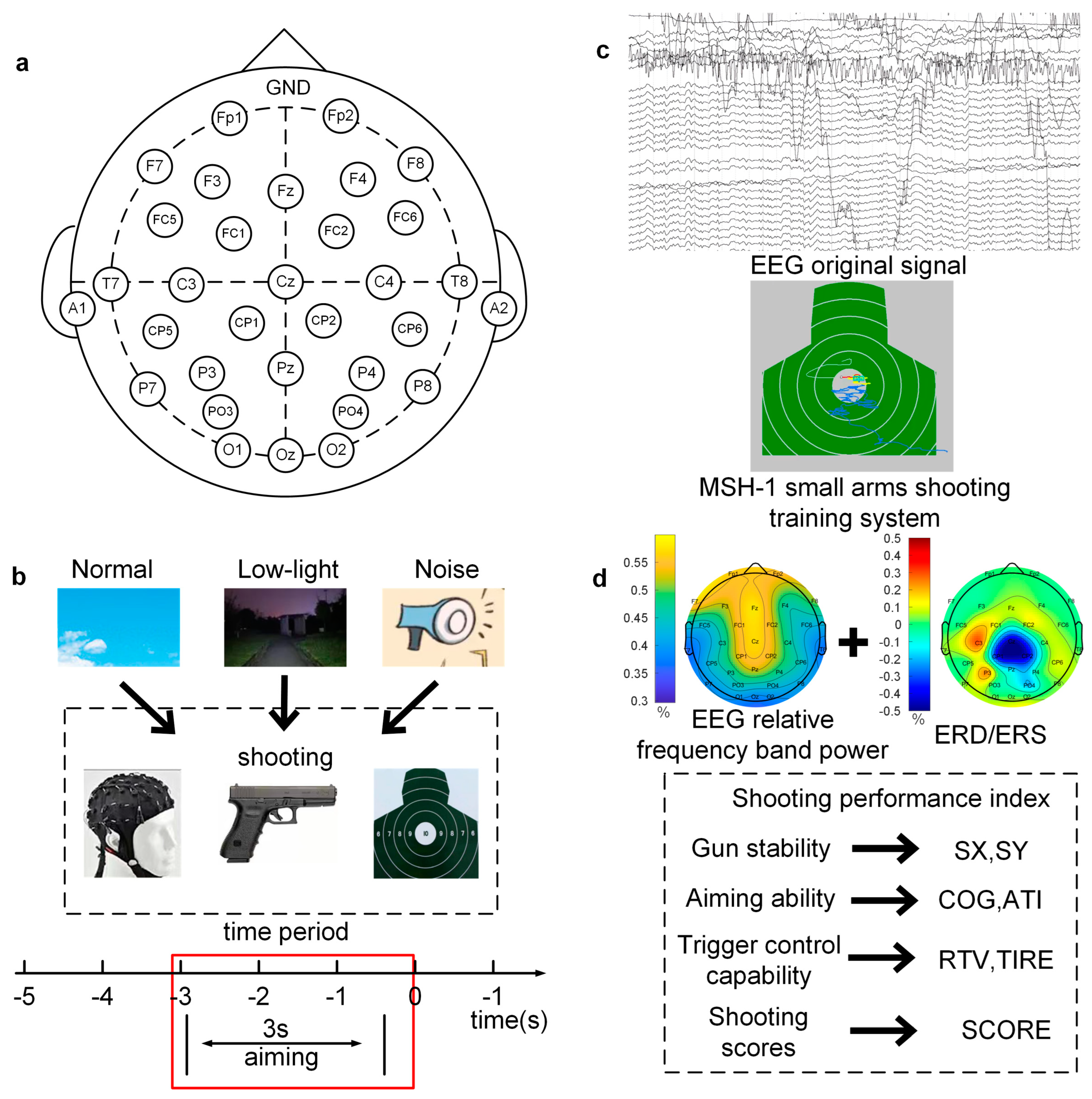
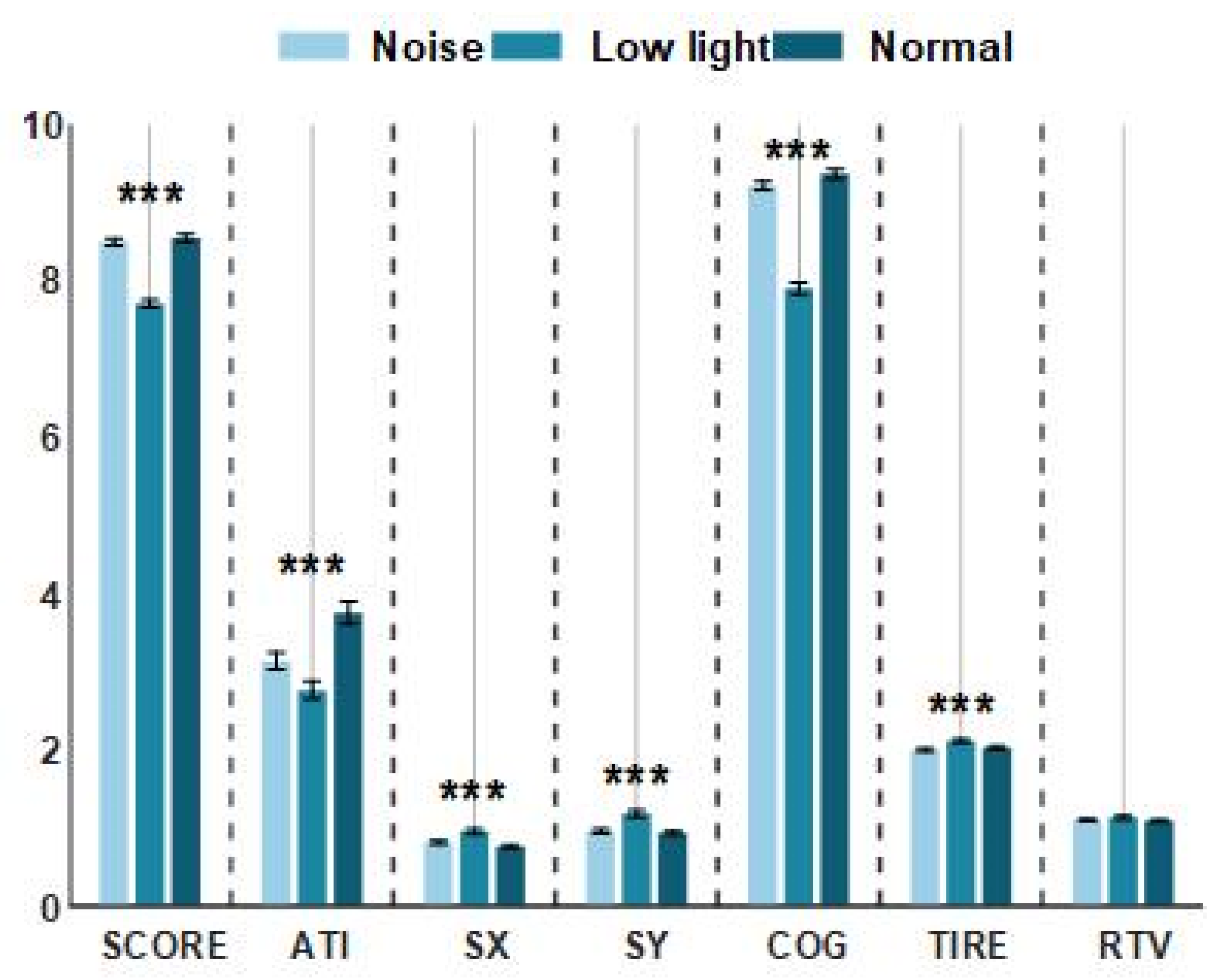

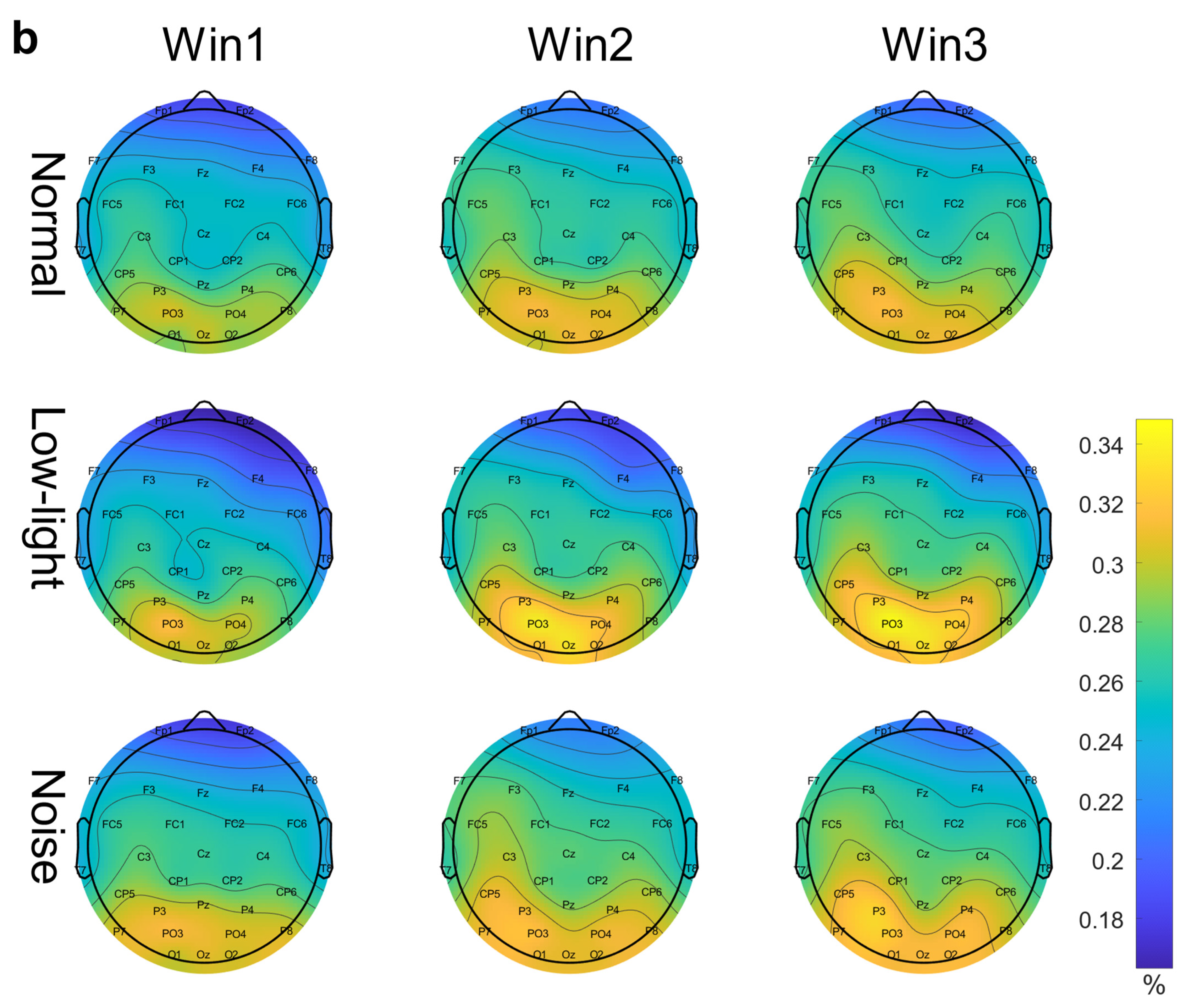


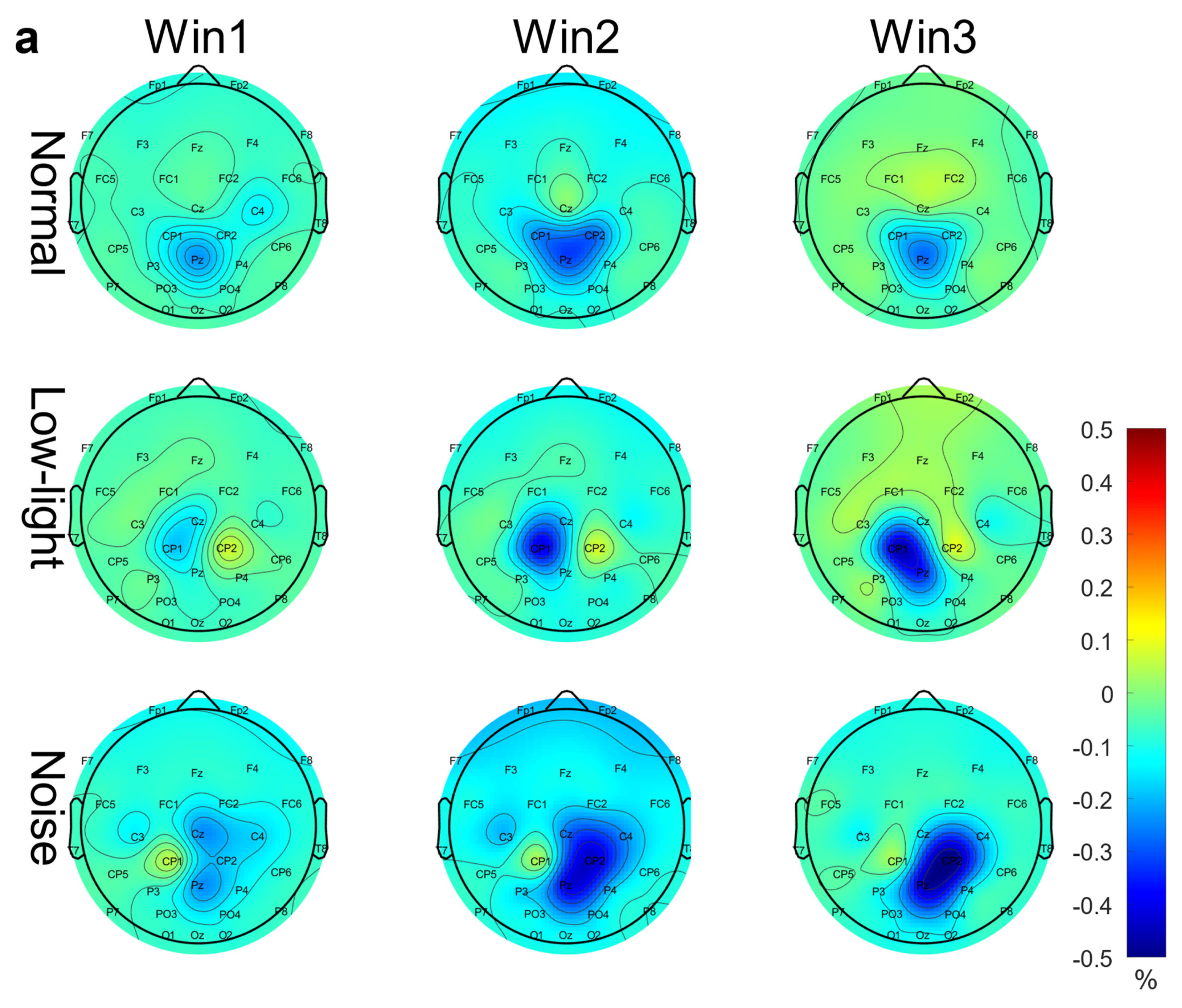
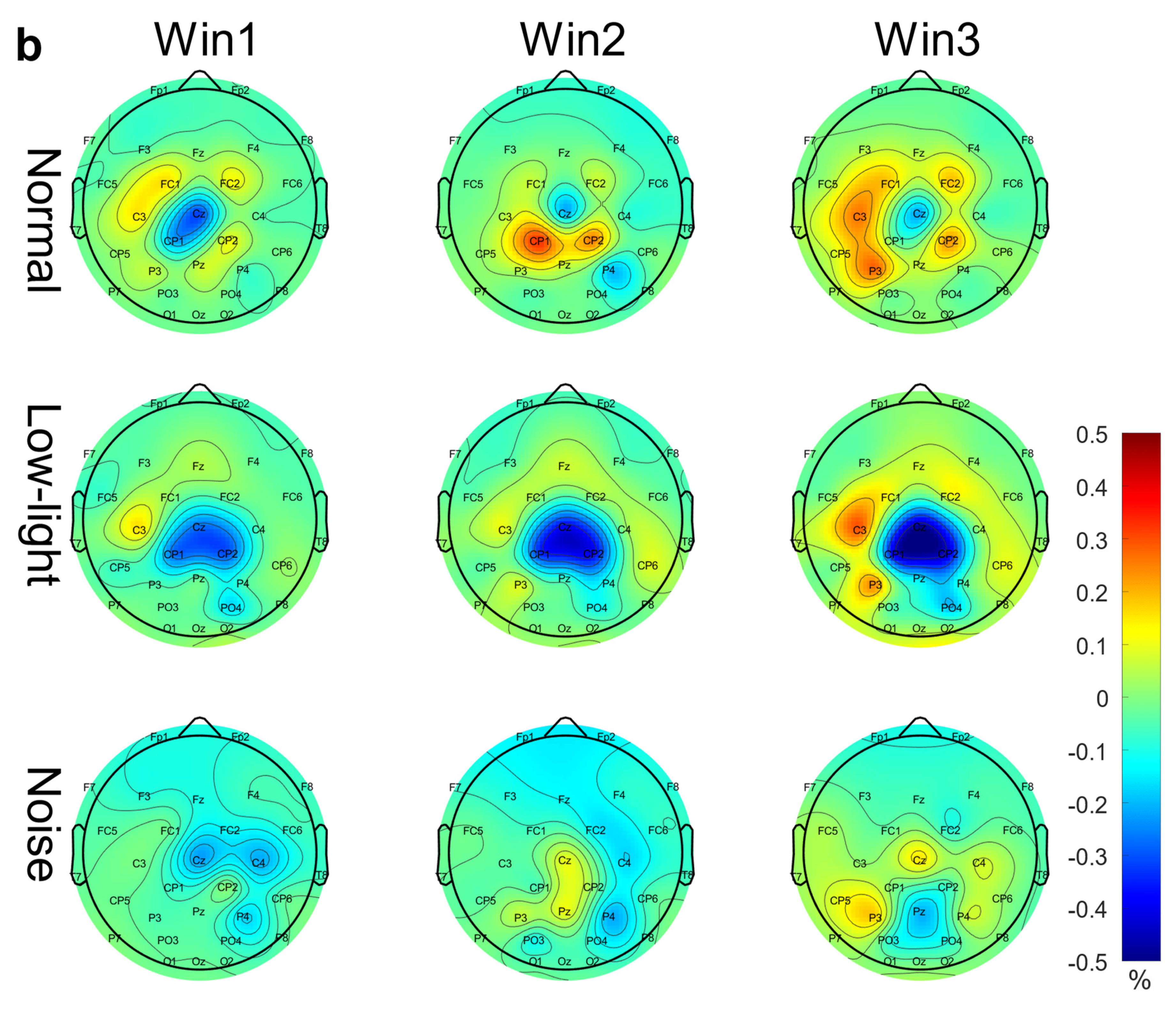
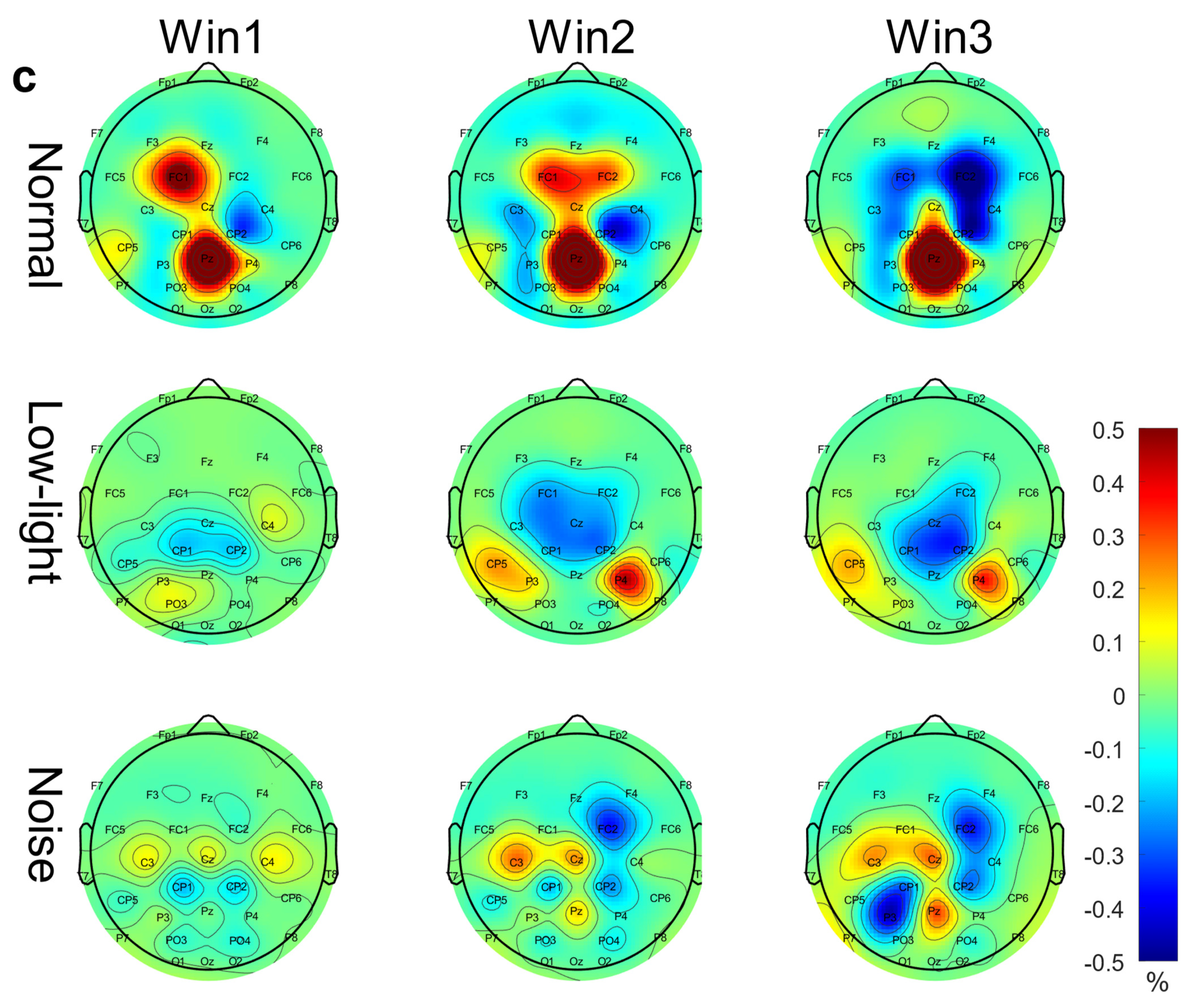
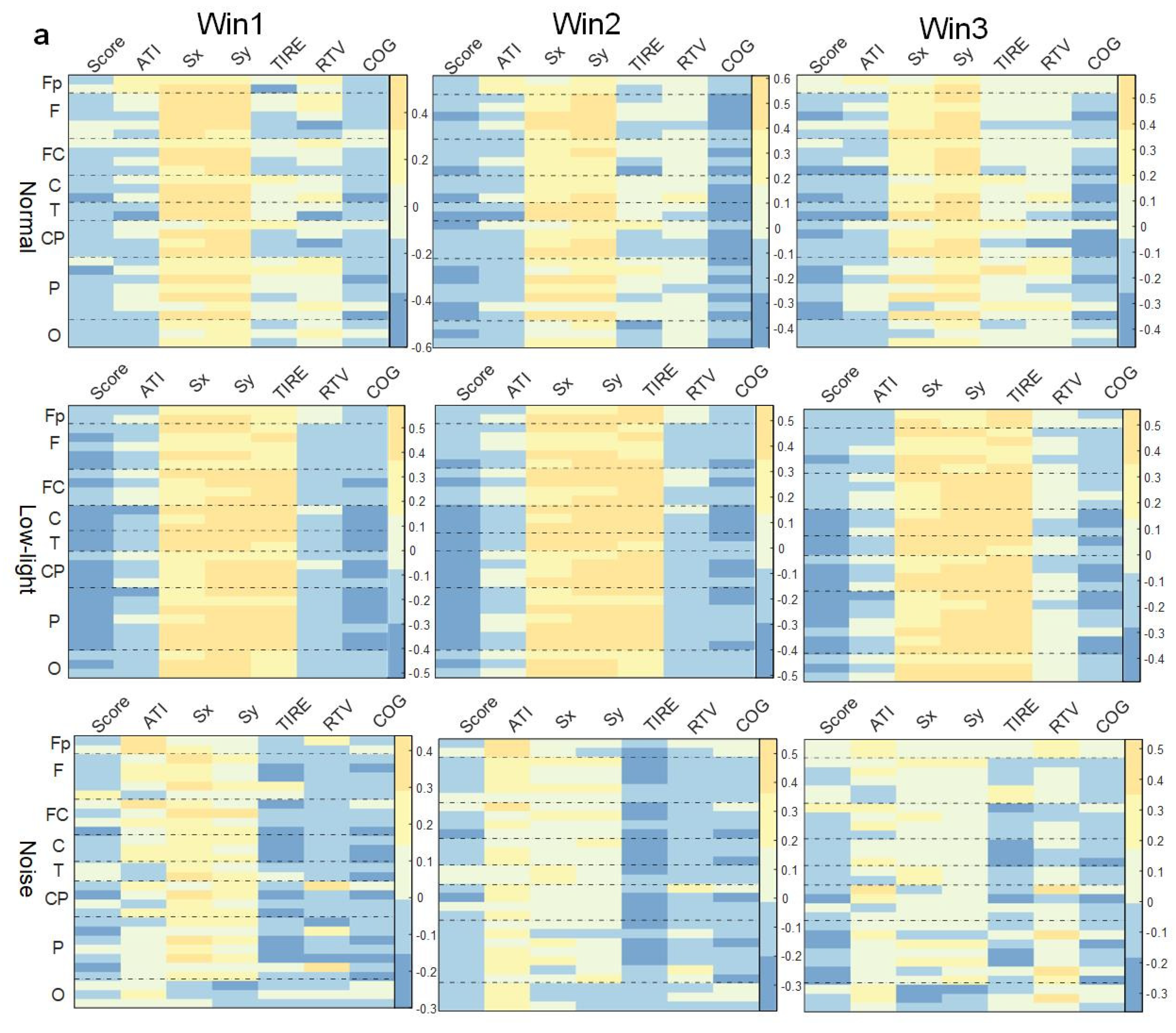

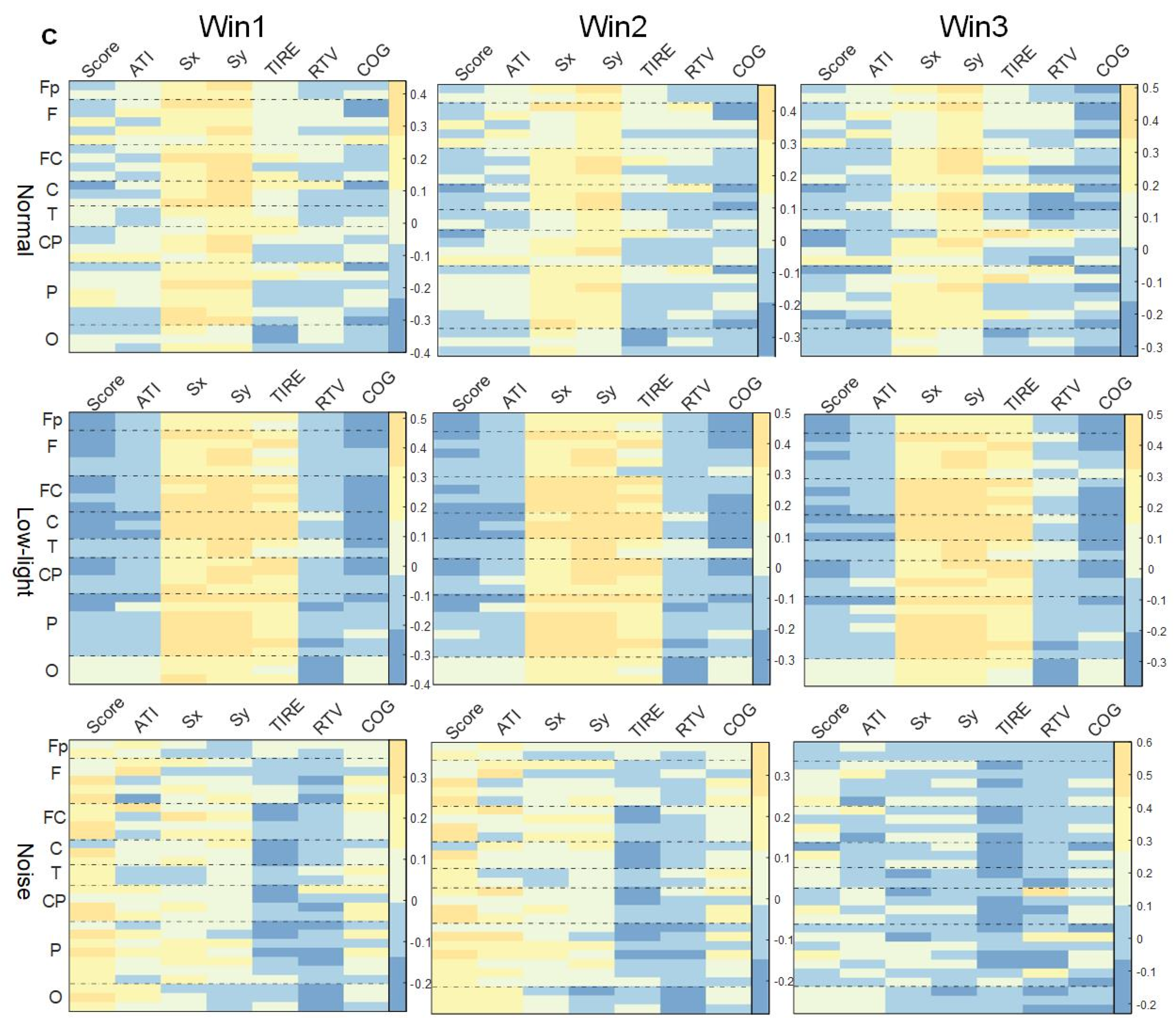


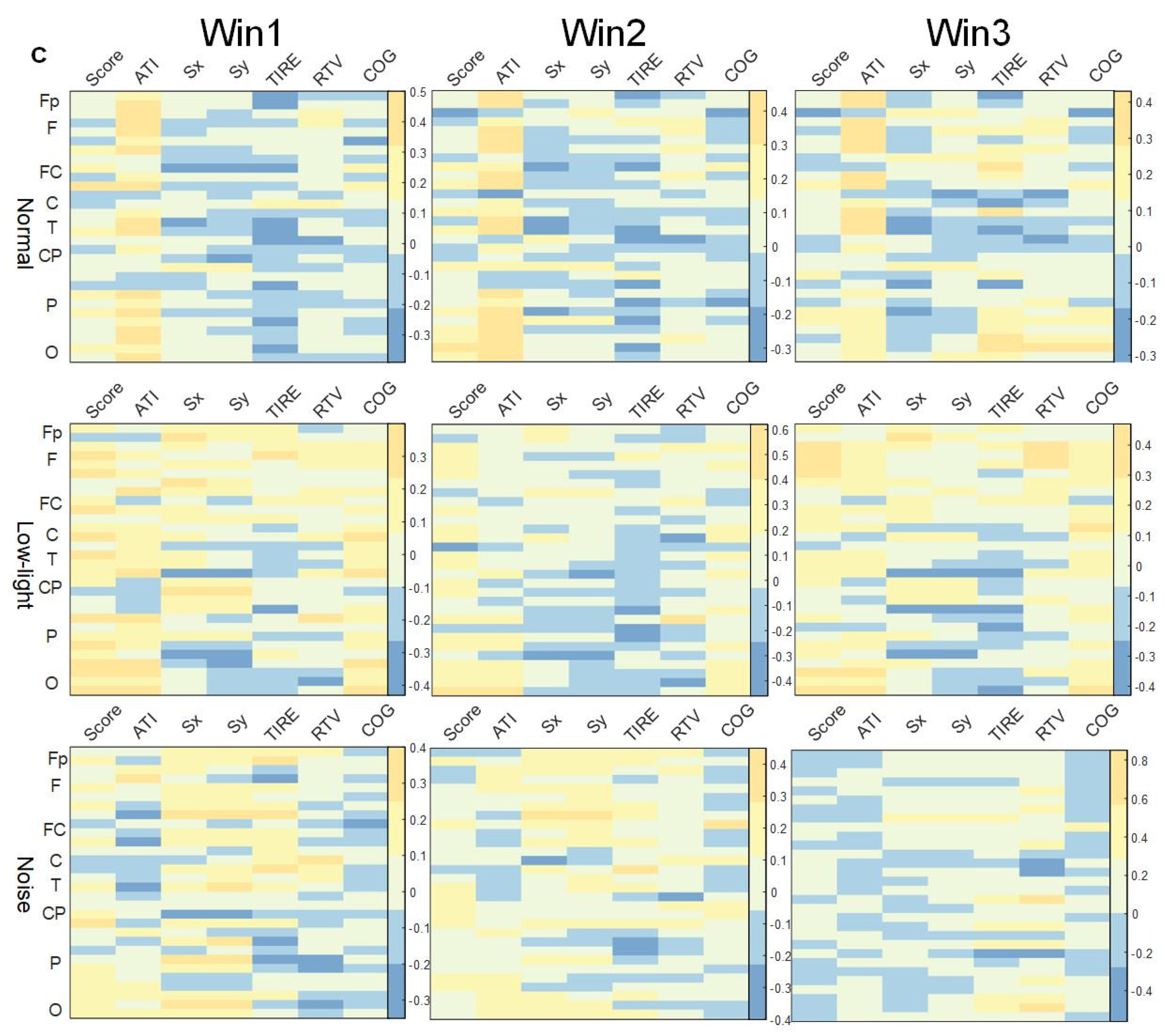
| Noise M (SD) | Low-Light M (SD) | Normal M (SD) | F | △ (Normal–Noise) | ▲ (Normal–Low-light) | |
|---|---|---|---|---|---|---|
| SCORE *** | 8.50 (0.38) | 7.71 (0.43) | 8.55 (0.46) | 85.73 | 0.05 | 0.84 b |
| ATI *** | 3.14 (0.99) | 2.76 (1.00) | 3.75 (1.29) | 14.86 | 0.61 a | 0.99 b |
| SX *** | 0.82 (0.23) | 0.96 (0.29) | 0.77 (0.22) | 14.62 | −0.05 | −0.19 b |
| SY *** | 0.96 (0.26) | 1.19 (0.36) | 0.94 (0.24) | 16.76 | −0.02 | −0.25 b |
| COG *** | 9.22 (0.49) | 7.91 (0.65) | 9.37 (0.57) | 127.9 | 0.15 | 1.46 b |
| TIRE *** | 2.00 (0.17) | 2.12 (0.21) | 2.03 (0.19) | 6.900 | 0.03 | −0.09 b |
| RTV | 1.11 (0.47) | 1.14 (0.61) | 1.10 (1.91) | 1.920 | −0.01 | −0.04 |
| Conditions | Time Window | |||||||||||
|---|---|---|---|---|---|---|---|---|---|---|---|---|
| M (SD) | M (SD) | |||||||||||
| F | Nor | L | No | Post Hoc | F | Win1 | Win2 | Win3 | Post-Hoc | |||
| Fp1 | 4.58 ** | 0.48 (0.16) | 0.45 (0.18) | 0.52 (0.16) | No > L, Nor | Fp1 | 6.05 *** | 0.52 (0.18) | 0.44 (0.16) | 0.50 (0.16) | 1, 3 > 2 | |
| Fp2 | 7.07 *** | 0.18 (0.17) | 0.43 (0.20) | 0.52 (0.17) | No > L, Nor | Fp2 | 5.94 *** | 0.50 (0.19) | 0.43 (0.17) | 0.50 (0.18) | 1, 3 > 2 | |
| F4 | 3.31 ** | 0.45 (0.13) | 0.41 (0.17) | 0.46 (0.13) | No > L, Nor | F3 | 3.52 ** | 0.51 (0.11) | 0.48 (0.10) | 0.49 (0.11) | 1 > 2 | |
| F8 | 3.91 ** | 0.49 (0.17) | 0.43 (0.19) | 0.49 (0.17) | Nor, No > L | F7 | 4.47 ** | 0.55 (0.14) | 0.50 (0.14) | 0.52 (0.14) | 1 > 2 | |
| T7 | 3.31 ** | 0.35 (0.14) | 0.31 (0.13) | 0.34 (0.12) | No, Nor > L | |||||||
| CP2 | 4.29 ** | 0.56 (0.11) | 0.54 (0.11) | 0.52 (0.11) | Nor > No, L | |||||||
| P7 | 4.58 ** | 0.38 (0.12) | 0.34 (0.12) | 0.38 (0.12) | Nor > L, No > L | |||||||
| PO3 | 3.07 ** | 0.45 (0.12) | 0.41 (0.12) | 0.44 (0.13) | - | |||||||
| Conditions | Time Window | |||||||||||
|---|---|---|---|---|---|---|---|---|---|---|---|---|
| M (SD) | M (SD) | |||||||||||
| F | Nor | L | No | Post Hoc | F | Win1 | Win2 | Win3 | Post-Hoc | |||
| Fp1 | 6.12 *** | 0.21 (0.05) | 0.19 (0.06) | 0.21 (0.06) | Nor > L, No > L | Fp1 | 7.96 *** | 0.19 (0.05) | 0.21 (0.06) | 0.21 (0.06) | 1 < 3, 2 | |
| Fp2 | 10.9 *** | 0.20 (0.05) | 0.17 (0.06) | 0.20 (0.05) | Nor > L, No > L | Fp2 | 6.78 *** | 0.18 (0.05) | 0.20 (0.06) | 0.19 (0.05) | 1 < 2 | |
| F4 | 11.6 *** | 0.24 (0.05) | 0.21 (0.06) | 0.21 (0.06) | Nor > L, No > L | Fz | 3.35 ** | 0.24 (0.05) | 0.26 (0.05) | 0.26 (0.06) | - | |
| F8 | 8.16 ** | 0.23 (0.07) | 0.20 (0.07) | 0.24 (0.08) | Nor > L, No > L | F3 | 6.55 *** | 0.24 (0.05) | 0.27 (0.06) | 0.27 (0.06) | 1 < 2, 3 | |
| T8 | 3.03 ** | 0.24 (0.08) | 0.22 (0.08) | 0.25 (0.07) | - | F4 | 3.14 ** | 0.22 (0.05) | 0.24 (0.06) | 0.24 (0.06) | - | |
| P8 | 3.99 ** | 0.29 (0.05) | 0.28 (0.07) | 0.30 (0.05) | No > L, Nor | F7 | 4.73 *** | 0.23 (0.08) | 0.26 (0.09) | 0.26 (0.09) | 1 < 2 | |
| F8 | 3.47 ** | 0.21 (0.08) | 0.23 (0.08) | 0.23 (0.07) | - | |||||||
| FC5 | 3.32 ** | 0.26 (0.06) | 0.28 (0.07) | 0.28 (0.08) | - | |||||||
| C4 | 3.14 ** | 0.26 (0.06) | 0.27 (0.06) | 0.28 (0.07) | - | |||||||
| CP1 | 4.85 *** | 0.26 (0.07) | 0.27 (0.07) | 0.29 (0.07) | 1 < 3 | |||||||
| P4 | 3.15 ** | 0.29 (0.06) | 0.30 (0.06) | 0.31 (0.06) | - | |||||||
| O2 | 3.41 ** | 0.30 (0.07) | 0.31 (0.06) | 0.32 (0.06) | 1 < 3 | |||||||
| Conditions | |||||
|---|---|---|---|---|---|
| M (SD) | |||||
| F | Nor | L | No | Post-Hoc | |
| Fp1 | 7.94 *** | 0.30 (0.17) | 0.35 (0.18) | 0.27 (0.16) | L > No, Nor |
| Fp2 | 11.0 *** | 0.32 (0.18) | 0.39 (0.21) | 0.28 (0.18) | L > Nor, L > No |
| Fz | 5.71 *** | 0.18 (0.07) | 0.21 (0.10) | 0.17 (0.08) | L > Nor, L > No |
| F3 | 3.08 ** | 0.24 (0.10) | 0.27 (0.12) | 0.23 (0.10) | - |
| F4 | 7.95 *** | 0.31 (0.15) | 0.38 (0.19) | 0.30 (0.14) | L > Nor, L > No |
| F8 | 9.64 *** | 0.28 (0.17) | 0.36 (0.20) | 0.27 (0.16) | L > Nor, L > No |
| FC6 | 4.46 ** | 0.31 (0.15) | 0.37 (0.17) | 0.31 (0.17) | L > Nor, No |
| T7 | 3.12 ** | 0.40 (0.17) | 0.45 (0.17) | 0.40 (0.16) | - |
| P7 | 5.04 *** | 0.32 (0.13) | 0.36 (0.15) | 0.31 (0.13) | L > No, Nor |
| P8 | 5.09 *** | 0.31 (0.12) | 0.35 (0.14) | 0.30 (0.12) | L > No, Nor |
| Conditions | Time window | ||||||||||
|---|---|---|---|---|---|---|---|---|---|---|---|
| M (SD) | M (SD) | ||||||||||
| F | Nor | L | No | Post-Hoc | F | Win1 | Win2 | Win3 | Post-Hoc | ||
| Fp1 | 9.98 *** | −9.9 (0.04) | −5.1 (0.07) | −14 (0.05) | L > Nor, No | Fp1 | 7.96 *** | −9.4 (0.03) | −15 (0.04) | −4.4 (0.06) | 3 > 1 > 2 |
| Fp2 | 8.81 *** | −8.7 (0.05) | −4.5 (0.08) | −13 (0.05) | L > No | Fp2 | 6.78 *** | −9.2 (0.03) | −15 (0.04) | −2.7 (0.08) | 3 > 1 > 2 |
| Fz | 6.03 *** | −5.1 (0.04) | −2.5 (0.04) | −9.3 (0.03) | L > No | Fz | 3.35 ** | −6.1 (0.03) | −8.8 (0.03) | −1.9 (0.04) | 3 > 2 |
| F3 | 4.66 ** | −7.0 (0.04) | −4.8 (0.04) | −10 (0.03) | L > No | F3 | 6.55 *** | −7.6 (0.02) | −11 (0.03) | −3.7 (0.04) | 3 > 2 |
| F4 | 4.74 *** | −8.1 (0.04) | −5.6 (0.04) | −12 (0.03) | L > No | F4 | 3.14 ** | −7.9 (0.02) | −12 (0.03) | −4.9 (0.04) | 3 > 2 |
| F7 | 6.09 *** | −8.9 (0.03) | −5.7 (0.03) | −12 (0.04) | L > No | F7 | 4.73 *** | −7.2 (0.03) | −12 (0.04) | −6.8 (0.03) | 3, 1 > 2 |
| F8 | 4.13 ** | −9.0 (0.03) | −7.3 (0.04) | −13 (0.03) | L > No | F8 | 3.47 ** | −8.9 (0.02) | −13 (0.03) | −6.9 (0.03) | 3 > 2 |
| FC1 | 3.49 ** | −4.4 (0.05) | −3.4 (0.05) | −9.3 (0.03) | L > No | FC1 | 3.32 ** | −6.1 (0.03) | −10 (0.02) | −8.4 (0.04) | 3 > 2 |
| FC2 | 4.57 ** | −5.3 (0.06) | −3.3 (0.05) | −11 (0.03) | L > No | FC2 | 3.14 ** | −7.5 (0.03) | −11 (0.03) | −1.6 (0.07) | 3 > 2 |
| FC6 | 3.17 ** | −6.6 (0.02) | −5.7 (0.03) | −9.8 (0.03) | - | FC5 | 4.85 *** | −5.9 (0.01) | −8.9 (0.02) | −2.2 (0.02) | 3 > 2 |
| CP1 | 4.09 ** | −19 (0.09) | −1.3 (0.20) | 3.53 (0.02) | No > L | FC6 | 3.15 ** | −7.3 (0.03) | −10 (0.03) | −4.7 (0.02) | 3 > 2 |
| CP2 | 4.06 ** | −2.1 (0.05) | 0.43 (0.45) | −36 (0.18) | L > No | O1 | 3.41 ** | −6.8 (0.01) | −10 (0.02) | −8.2 (0.03) | 1 > 2 |
| CP6 | 3.60 ** | −3.4 (0.01) | −4.2 (0.01) | −8.2 (0.03) | - | ||||||
| P4 | 3.52 ** | −6.7 (0.03) | −6.9 (0.02) | −13 (0.03) | - | ||||||
| P8 | 5.32 *** | −4.0 (0.02) | −3.9 (0.03) | −8.2 (0.02) | Nor, L > No | ||||||
| PO3 | 3.32 ** | −7.9 (0.02) | −7.9 (0.02) | −11 (0.02) | - | ||||||
| PO4 | 4.84 *** | −8.0 (0.02) | −7.4 (0.02) | −12 (0.02) | L, Nor > No | ||||||
| O1 | 4.06 ** | −7.6 (0.02) | −7.2 (0.02) | −10 (0.02) | L > No | ||||||
| O2 | 3.81 ** | −8.4 (0.03) | −7.6 (0.03) | −11 (0.04) | L > No | ||||||
| Conditions | Time Window | ||||||||||
|---|---|---|---|---|---|---|---|---|---|---|---|
| M (SD) | M (SD) | ||||||||||
| F | Nor | L | No | Post-Hoc | F | Win1 | Win2 | Win3 | Post-Hoc | ||
| Fp1 | 7.60 *** | −7.2 (0.02) | −4.1 (0.03) | −10 (0.05) | L > No | Fp1 | 3.54 ** | −7.1 (0.02) | −9.8 (0.03) | −5.0 (0.04) | 3 > 2 |
| Fp2 | 9.35 *** | −5.9 (0.03) | −3.5 (0.04) | −10 (0.03) | L, Nor > No | Fp2 | 5.84 *** | −6.4 (0.03) | −9.5 (0.04) | −3.8 (0.05) | 3 > 2 |
| Fz | 8.25 *** | −0.1 (0.04) | 5.01 (0.02) | −8.3 (0.04) | L > No | F3 | 3.06 ** | −5.7 (0.03) | −6.2 (0.02) | 0.16 (0.04) | - |
| FC1 | 5.34 *** | 18 (0.06) | 6.40 (0.04) | −3.2 (0.02) | Nor > No | F4 | 3.12 ** | −4.4 (0.02) | −7.2 (0.02) | −2.0 (0.02) | 3 > 2 |
| Cz | 5.28 *** | −53 (0.26) | −20 (0.04) | 8.24 (0.03) | No > Nor | FC5 | 3.92 ** | −4.8 (0.01) | −3.3 (0.01) | 3.69 (0.01) | 3 > 1 |
| C3 | 3.31 ** | 12 (0.11) | 13 (0.08) | −25 (0.04) | - | FC6 | 3.10 ** | −4.2 (0.03) | −4.9 (0.02) | −0.03 (0.02) | - |
| T8 | 3.54 ** | −3.5 (0.02) | −1.9 (0.02) | −5.7 (0.02) | L > No | T7 | 9.20 *** | −1.9 (0.01) | −0.3 (0.02) | 4.59 (0.01) | 3 > 2, 1 |
| CP5 | 5.18 *** | 23 (0.05) | −1.5 (0.04) | 3.62 (0.09) | Nor > L | P3 | 4.20 ** | −3.9 (0.05) | 3.02 (0.04) | 18 (0.01) | 3 > 1 |
| P7 | 8.17 *** | −0.7 (0.01) | 0.59 (0.01) | 5.15 (0.01) | 3 > 2, 1 | ||||||
| P8 | 3.86 ** | −2.5 (0.01) | −2.6 (0.02) | 1.43 (0.02) | - | ||||||
| Conditions | Time Window | ||||||||||
|---|---|---|---|---|---|---|---|---|---|---|---|
| M (SD) | M (SD) | ||||||||||
| F | Nor | L | No | Post-Hoc | F | Win1 | Win2 | Win3 | Post-Hoc | ||
| F4 | 3.59 ** | −7.5 (0.04) | −3.3 (0.02) | −5.3 (0.03) | L > Nor | Fp1 | 5.01 *** | −0.4 (0.01) | −2.5 (0.01) | −4.3 (0.01) | 1 > 3 |
| F7 | 4.41 ** | −5.7 (0.02) | −1.6 (0.01) | −4.4 (0.01) | L > Nor | Fp2 | 7.43 *** | −0.2 (0.01) | −3.2 (0.01) | −4.6 (0.01) | 1 > 2, 3 |
| FC5 | 5.76 *** | −4.4 (0.01) | 1.29 (0.01) | −3.1 (0.01) | L > Nor, No | F4 | 5.54 *** | −2.1 (0.01) | −6.7 (0.03) | −7.4 (0.03) | 1 > 2, 3 |
| FC6 | 3.52 ** | −5.8 (0.03) | −1.9 (0.01) | −2.2 (0.02) | L > Nor | P7 | 6.01 *** | 1.33 (0.02) | 2.02 (0.02) | 6.92 (0.02) | 3 > 2, 1 |
| Cz | 7.01 *** | 21 (0.04) | −16 (0.07) | 17 (0.08) | Nor, No > L | O1 | 3.65 ** | −1.9 (0.01) | −3.4 (0.01) | 2.02 (0.01) | 3 > 2 |
| C3 | 6.88 *** | −17 (0.09) | −8.7 (0.05) | 19 (0.08) | L > No, Nor | ||||||
| T7 | 6.78 *** | −3.5 (0.02) | −1.9 (0.02) | 0.43 (0.00) | L, No > Nor | ||||||
| T8 | 3.89 ** | −2.4 (0.01) | −0.6 (0.01) | 1.64 (0.01) | No > Nor | ||||||
| CP5 | 4.22 ** | 5.01 (0.02) | 27 (0.21) | −5.3 (0.06) | L > No | ||||||
Disclaimer/Publisher’s Note: The statements, opinions and data contained in all publications are solely those of the individual author(s) and contributor(s) and not of MDPI and/or the editor(s). MDPI and/or the editor(s) disclaim responsibility for any injury to people or property resulting from any ideas, methods, instructions or products referred to in the content. |
© 2023 by the authors. Licensee MDPI, Basel, Switzerland. This article is an open access article distributed under the terms and conditions of the Creative Commons Attribution (CC BY) license (https://creativecommons.org/licenses/by/4.0/).
Share and Cite
Shi, Q.; Gong, A.; Ding, P.; Wang, F.; Fu, Y. Neural Mechanisms of Visual–Spatial Judgment Behavior under Visual and Auditory Constraints: Evidence from an Electroencephalograph during Handgun Shooting. Brain Sci. 2023, 13, 1702. https://doi.org/10.3390/brainsci13121702
Shi Q, Gong A, Ding P, Wang F, Fu Y. Neural Mechanisms of Visual–Spatial Judgment Behavior under Visual and Auditory Constraints: Evidence from an Electroencephalograph during Handgun Shooting. Brain Sciences. 2023; 13(12):1702. https://doi.org/10.3390/brainsci13121702
Chicago/Turabian StyleShi, Qidi, Anmin Gong, Peng Ding, Fan Wang, and Yunfa Fu. 2023. "Neural Mechanisms of Visual–Spatial Judgment Behavior under Visual and Auditory Constraints: Evidence from an Electroencephalograph during Handgun Shooting" Brain Sciences 13, no. 12: 1702. https://doi.org/10.3390/brainsci13121702
APA StyleShi, Q., Gong, A., Ding, P., Wang, F., & Fu, Y. (2023). Neural Mechanisms of Visual–Spatial Judgment Behavior under Visual and Auditory Constraints: Evidence from an Electroencephalograph during Handgun Shooting. Brain Sciences, 13(12), 1702. https://doi.org/10.3390/brainsci13121702





